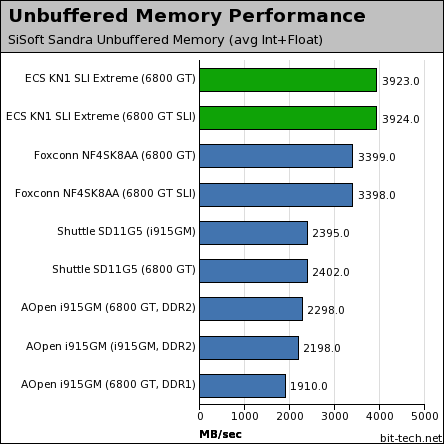Testing Methods:
After a recent editorial, we have decided to change the way we review motherboards here at bit-tech. We've moved our focus away from synthetic benchmarks that provide meaningless numbers from scenarios the consumer rarely finds themselves in.With the exception of SiSoft Sandra's unbuffered memory bandwidth benchmark - which, incidentally, measures real memory bandwidth when you need it most - all of our benchmarks have been engineered to give you numbers that you are likely to find useful when actually using the products we have evaluated in the real world. There are plans to increase the number of benchmarks over time and we're running additional tests that will not be published until we have enough products to make a reasonable comparison.
We are also focusing a lot more of our time on evaluating the stability of the motherboards (and platforms) using a stress test designed to highlight any of the potential weaknesses that the product may have. That involves a gradually increasing amount of stress starting with Prime95 and expanding to IOMeter and 3DMark03 if all is well. This is to ensure that all parts of the system are stressed simultaneously over a period of time.
We believe that the consumer is never likely to subject their platform to this level of stress and we are not expecting every product to complete an entire extended stress test. However, most poorly engineered products fail within the first couple of hours, or even minutes, allowing us to make a conscious decision on whether a motherboard (or platform) is worth your money, regardless of how well it performs in our benchmarks.
Test Setup:
AMD Athlon 64 4000+ (operating at 2400MHz - 12x200); ECS KN1 SLI Extreme; 2 x 512MB Corsair 3200XL Pro (operating in dual channel with 2.0-2-2-5-1T timings); NVIDIA GeForce 6800 GT (operating at 350/1000MHz); Western Digital 74GB Raptor 10,000RPM SATA 150 Hard disk drive; Windows XP Professional Service Pack 2; DirectX 9.0c; NVIDIA ForceWare 71.89 WHQL.AMD Athlon 64 4000+ (Clawhammer, 1MB L2); Foxconn WinFast NF4SK8AA-8EKRS (NVIDIA NForce 4 SLI); 2 x 512MB Corsair 3200XL Pro (operating at 400MHz with 2.0-2-2-5-1T timings); NVIDIA GeForce 6800 GT (operating at 350/1000MHz); Western Digital Raptor 74GB; Windows XP Professional Service Pack 2; DirectX 9.0c; NVIDIA ForceWare 71.89 WHQL.
Intel Pentium M 2.13GHz (133x16, 2MB L2); Shuttle SD11G5; 2 x 512MB Corsair 5400UL DDR2 (operating at 533MHz in dual channel with 3.0-2-2-8 timings); NVIDIA GeForce 6800 GT (operating at 350/1000MHz); Western Digital Raptor 74GB; Windows XP Professional Service Pack 2; DirectX 9.0c; NVIDIA ForceWare 71.89 WHQL, Intel Inf 7.00.1.
Intel Pentium M 2.13GHz (133x16, 2MB L2); AOpen i915GMm-HFS; 2 x 512MB Corsair 5400UL DDR2 (operating at 533MHz in dual channel with 3.0-2-2-8 timings); NVIDIA GeForce 6800 GT (operating at 350/1000MHz); Western Digital Raptor 74GB; Windows XP Professional Service Pack 2; DirectX 9.0c; NVIDIA ForceWare 71.89 WHQL, Intel Inf 7.00.1.
Intel Pentium M 2.13GHz (133x16, 2MB L2); AOpen i915GMm-HFS; 2 x 512MB Corsair 3200XL Pro (operating at 400MHz in dual channel with 2.0-2-2-5-1T timings); NVIDIA GeForce 6800 GT (operating at 350/1000MHz); Western Digital Raptor 74GB; Windows XP Professional Service Pack 2; DirectX 9.0c; NVIDIA ForceWare 71.89 WHQL, Intel Inf 7.00.1.
Memory Performance:

Stability & Overclocking:
During the latter stages of our testing, we had an Ethernet port failure. We don't believe that this problem is a product-wide issue - more related to the fact that this board was an early sample when we first recieved it for review around three months ago (before our 'QA' editorial). Since then, we've waited for a production BIOS in order to fix the majority of our the stability issues we were having. ECS have explained to us that this is the first they've heard of ethernet port failures on the KN1 SLI Extreme.Having said all of that, the ECS KN1 SLI Extreme was 100% stable at its stock speeds during our on going stress test. We experienced no hiccups when running Prime95, IOMeter in the background while a FarCry timedemo was continuously looping in the foreground. The new BIOS fixed all of the stability-related problems we had and it was a little unfortunate for the Ethernet port to die some time after we had completed our stress testing with the latest official BIOS.
We overclocked the motherboard to 12x220MHz, finding that it was able to get in to Windows and run a SuperPI 1M benchmark, but it was unable to run the Prime95 blend torture test for more than a minute. At 12x223MHz, we were able to get the system to POST, but not boot in to Windows, despite loosening the memory timings and increasing voltages. We found that the board was 100% stable with our 4000+ CPU at 12x213MHz.

MSI MPG Velox 100R Chassis Review
October 14 2021 | 15:04






Want to comment? Please log in.